You are here: CLASSE Wiki>Safety/Handbook Web>RadiationSafety>CHESSInterlockSystem (26 Apr 2012, bkh)Edit Attach
The CHESS interlock system follows procedures similar to those for CESR. The entrances to East and West CHESS are interlocked, as is the door between the two flares.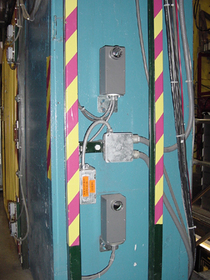 There are essentially two types of interlocks and associated keys: white and other. A "white key" interlock is an interlock that leads directly to the CESR tunnel or to an area that cannot be entered when the beam is on. At no time while the linac or CESR is running can you enter a white interlock without tripping an interlock and dumping the beam.
Other interlocks, located in CHESS West and CHESS East can be set in "bypass" mode with a color-coded key that allows users and personnel to pass through interlocks to the experimental floor and work stations even when CESR is on. The CHESS West interlock requires a red key be in place to set it in bypass mode. The CHESS East interlock requires a blue key.
If the interlocks are active, you must use a key to bypass the interlock system. Yellow keys allow access to CHESS when the "INTERLOCKS SET, TAKE A KEY" sign is on. The yellow keys are located near the operator's desk in the CHESS control room.
To find out more about the color-coded keys and the areas they allow access to, speak with the Operations Manager or an experienced CHESS Operator.
Because of the interactive nature of the experiments at CHESS, interlocks at the entrance to CHESS East and West are usually in bypass mode during experiments. The bypass mode allows more freedom of movement. We rely on effective shielding to protect workers in these areas, with interlocked radiation monitors to shut off the accelerator(s) as a backup. When interlocks are bypassed, or a key is removed when interlocks are active, the radiation monitors in the appropriate CHESS area will turn off the linac (or in some cases CESR beams) if radiation levels exceed preset limits.
Radiation monitors in the G-line Area are always interlocked to turn off the linac and CESR. CHESS G-line stations and caves, and the immediately adjacent spaces are designated as controlled areas, which requires personnel to wear a radiation badge. The portion of the G-line Area dedicated to student office space is not a controlled area.
A lead-faced concrete wall separating CESR from CHESS East and West (see map) absorbs the radiation coming from CESR and CLEO. In addition, CHESS has shielded rooms (called hutches, caves, or stations) to keep any x-rays being used in experiments from posing danger to people on the outside. Safety features such as dump buttons, search buttons, door interlocks, kirk key systems, and station enable keys ensure that no one is inside hutches or caves while x-rays are present.
There are essentially two types of interlocks and associated keys: white and other. A "white key" interlock is an interlock that leads directly to the CESR tunnel or to an area that cannot be entered when the beam is on. At no time while the linac or CESR is running can you enter a white interlock without tripping an interlock and dumping the beam.
Other interlocks, located in CHESS West and CHESS East can be set in "bypass" mode with a color-coded key that allows users and personnel to pass through interlocks to the experimental floor and work stations even when CESR is on. The CHESS West interlock requires a red key be in place to set it in bypass mode. The CHESS East interlock requires a blue key.
If the interlocks are active, you must use a key to bypass the interlock system. Yellow keys allow access to CHESS when the "INTERLOCKS SET, TAKE A KEY" sign is on. The yellow keys are located near the operator's desk in the CHESS control room.
To find out more about the color-coded keys and the areas they allow access to, speak with the Operations Manager or an experienced CHESS Operator.
Because of the interactive nature of the experiments at CHESS, interlocks at the entrance to CHESS East and West are usually in bypass mode during experiments. The bypass mode allows more freedom of movement. We rely on effective shielding to protect workers in these areas, with interlocked radiation monitors to shut off the accelerator(s) as a backup. When interlocks are bypassed, or a key is removed when interlocks are active, the radiation monitors in the appropriate CHESS area will turn off the linac (or in some cases CESR beams) if radiation levels exceed preset limits.
Radiation monitors in the G-line Area are always interlocked to turn off the linac and CESR. CHESS G-line stations and caves, and the immediately adjacent spaces are designated as controlled areas, which requires personnel to wear a radiation badge. The portion of the G-line Area dedicated to student office space is not a controlled area.
A lead-faced concrete wall separating CESR from CHESS East and West (see map) absorbs the radiation coming from CESR and CLEO. In addition, CHESS has shielded rooms (called hutches, caves, or stations) to keep any x-rays being used in experiments from posing danger to people on the outside. Safety features such as dump buttons, search buttons, door interlocks, kirk key systems, and station enable keys ensure that no one is inside hutches or caves while x-rays are present.
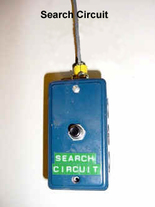
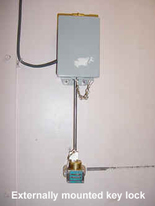 Before locking station doors in preparation for opening the beamstops, CHESS users search experimental areas and evacuate those who may be in a station. All caves and experimental stations in CHESS are equipped with clearly marked search buttons. These buttons activate an alarm that sounds for at least thirty seconds as a warning to whomever may be in the enclosed area. Each station is wired such that it is impossible to lock the doors or remove the station door key without first pressing the search button.
Before locking station doors in preparation for opening the beamstops, CHESS users search experimental areas and evacuate those who may be in a station. All caves and experimental stations in CHESS are equipped with clearly marked search buttons. These buttons activate an alarm that sounds for at least thirty seconds as a warning to whomever may be in the enclosed area. Each station is wired such that it is impossible to lock the doors or remove the station door key without first pressing the search button.
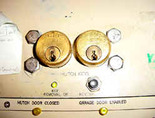 Removing a station enable key makes it impossible to open the beamstops on that station. Whenever the CHESS safety system is disabled or an operator or member of the CHESS Safety Committee finds the station being operated incorrectly, he or she has the right to disable the station.
Removing a station enable key makes it impossible to open the beamstops on that station. Whenever the CHESS safety system is disabled or an operator or member of the CHESS Safety Committee finds the station being operated incorrectly, he or she has the right to disable the station.
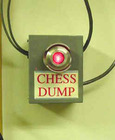 Pressing a dump button temporarily cuts CHESS off from the beam by closing beam stops. Dump buttons can be used in the rare case that someone is locked in an area that would expose him or her to x-rays from the beam. Dump buttons are clearly marked and are located inside every station and optics cave.
Pressing a dump button temporarily cuts CHESS off from the beam by closing beam stops. Dump buttons can be used in the rare case that someone is locked in an area that would expose him or her to x-rays from the beam. Dump buttons are clearly marked and are located inside every station and optics cave.
 There are essentially two types of interlocks and associated keys: white and other. A "white key" interlock is an interlock that leads directly to the CESR tunnel or to an area that cannot be entered when the beam is on. At no time while the linac or CESR is running can you enter a white interlock without tripping an interlock and dumping the beam.
Other interlocks, located in CHESS West and CHESS East can be set in "bypass" mode with a color-coded key that allows users and personnel to pass through interlocks to the experimental floor and work stations even when CESR is on. The CHESS West interlock requires a red key be in place to set it in bypass mode. The CHESS East interlock requires a blue key.
If the interlocks are active, you must use a key to bypass the interlock system. Yellow keys allow access to CHESS when the "INTERLOCKS SET, TAKE A KEY" sign is on. The yellow keys are located near the operator's desk in the CHESS control room.
To find out more about the color-coded keys and the areas they allow access to, speak with the Operations Manager or an experienced CHESS Operator.
Because of the interactive nature of the experiments at CHESS, interlocks at the entrance to CHESS East and West are usually in bypass mode during experiments. The bypass mode allows more freedom of movement. We rely on effective shielding to protect workers in these areas, with interlocked radiation monitors to shut off the accelerator(s) as a backup. When interlocks are bypassed, or a key is removed when interlocks are active, the radiation monitors in the appropriate CHESS area will turn off the linac (or in some cases CESR beams) if radiation levels exceed preset limits.
Radiation monitors in the G-line Area are always interlocked to turn off the linac and CESR. CHESS G-line stations and caves, and the immediately adjacent spaces are designated as controlled areas, which requires personnel to wear a radiation badge. The portion of the G-line Area dedicated to student office space is not a controlled area.
A lead-faced concrete wall separating CESR from CHESS East and West (see map) absorbs the radiation coming from CESR and CLEO. In addition, CHESS has shielded rooms (called hutches, caves, or stations) to keep any x-rays being used in experiments from posing danger to people on the outside. Safety features such as dump buttons, search buttons, door interlocks, kirk key systems, and station enable keys ensure that no one is inside hutches or caves while x-rays are present.
There are essentially two types of interlocks and associated keys: white and other. A "white key" interlock is an interlock that leads directly to the CESR tunnel or to an area that cannot be entered when the beam is on. At no time while the linac or CESR is running can you enter a white interlock without tripping an interlock and dumping the beam.
Other interlocks, located in CHESS West and CHESS East can be set in "bypass" mode with a color-coded key that allows users and personnel to pass through interlocks to the experimental floor and work stations even when CESR is on. The CHESS West interlock requires a red key be in place to set it in bypass mode. The CHESS East interlock requires a blue key.
If the interlocks are active, you must use a key to bypass the interlock system. Yellow keys allow access to CHESS when the "INTERLOCKS SET, TAKE A KEY" sign is on. The yellow keys are located near the operator's desk in the CHESS control room.
To find out more about the color-coded keys and the areas they allow access to, speak with the Operations Manager or an experienced CHESS Operator.
Because of the interactive nature of the experiments at CHESS, interlocks at the entrance to CHESS East and West are usually in bypass mode during experiments. The bypass mode allows more freedom of movement. We rely on effective shielding to protect workers in these areas, with interlocked radiation monitors to shut off the accelerator(s) as a backup. When interlocks are bypassed, or a key is removed when interlocks are active, the radiation monitors in the appropriate CHESS area will turn off the linac (or in some cases CESR beams) if radiation levels exceed preset limits.
Radiation monitors in the G-line Area are always interlocked to turn off the linac and CESR. CHESS G-line stations and caves, and the immediately adjacent spaces are designated as controlled areas, which requires personnel to wear a radiation badge. The portion of the G-line Area dedicated to student office space is not a controlled area.
A lead-faced concrete wall separating CESR from CHESS East and West (see map) absorbs the radiation coming from CESR and CLEO. In addition, CHESS has shielded rooms (called hutches, caves, or stations) to keep any x-rays being used in experiments from posing danger to people on the outside. Safety features such as dump buttons, search buttons, door interlocks, kirk key systems, and station enable keys ensure that no one is inside hutches or caves while x-rays are present.

 Before locking station doors in preparation for opening the beamstops, CHESS users search experimental areas and evacuate those who may be in a station. All caves and experimental stations in CHESS are equipped with clearly marked search buttons. These buttons activate an alarm that sounds for at least thirty seconds as a warning to whomever may be in the enclosed area. Each station is wired such that it is impossible to lock the doors or remove the station door key without first pressing the search button.
Before locking station doors in preparation for opening the beamstops, CHESS users search experimental areas and evacuate those who may be in a station. All caves and experimental stations in CHESS are equipped with clearly marked search buttons. These buttons activate an alarm that sounds for at least thirty seconds as a warning to whomever may be in the enclosed area. Each station is wired such that it is impossible to lock the doors or remove the station door key without first pressing the search button.
 Removing a station enable key makes it impossible to open the beamstops on that station. Whenever the CHESS safety system is disabled or an operator or member of the CHESS Safety Committee finds the station being operated incorrectly, he or she has the right to disable the station.
Removing a station enable key makes it impossible to open the beamstops on that station. Whenever the CHESS safety system is disabled or an operator or member of the CHESS Safety Committee finds the station being operated incorrectly, he or she has the right to disable the station.
 Pressing a dump button temporarily cuts CHESS off from the beam by closing beam stops. Dump buttons can be used in the rare case that someone is locked in an area that would expose him or her to x-rays from the beam. Dump buttons are clearly marked and are located inside every station and optics cave.
Pressing a dump button temporarily cuts CHESS off from the beam by closing beam stops. Dump buttons can be used in the rare case that someone is locked in an area that would expose him or her to x-rays from the beam. Dump buttons are clearly marked and are located inside every station and optics cave.
Edit | Attach | Print version | History: r5 < r4 < r3 < r2 | Backlinks | View wiki text | Edit wiki text | More topic actions
Topic revision: r5 - 26 Apr 2012, bkh
-
 Safety/Handbook Web
Safety/Handbook Web
-
 Create New Topic
Create New Topic
-
 Index
Index
-
 Search
Search
-
 Changes
Changes
-
 Notifications
Notifications
-
 RSS Feed
RSS Feed
-
 Statistics
Statistics
-
 Preferences
Preferences
- Webs
-
 ACC
ACC
-
 ACL
ACL
-
 Bunch
Bunch
-
 Private
Private
-
 BusinessOffice
BusinessOffice
-
 CBB
CBB
-
 NSF
NSF
-
 CBETA
CBETA
-
 CESR
CESR
-
 Private
Private
-
 CHESS
CHESS
-
 FMB
FMB
-
 Maia
Maia
-
 XIMG
XIMG
-
 CHEXS
CHEXS
-
 CLASSE
CLASSE
-
 Inventory
Inventory
-
 Communications
Communications
-
 CLEO
CLEO
-
 AC
AC
-
 Administration
Administration
-
 RunMan
RunMan
-
 SW
SW
-
 CMSPhase2MREFC
CMSPhase2MREFC
-
 Computing
Computing
-
 Blogs
Blogs
-
 Newsletter
Newsletter
-
 Obsolete
Obsolete
-
 Cosmology
Cosmology
-
 Private
Private
-
 DarkPhoton
DarkPhoton
-
 ERL
ERL
-
 Private
Private
-
 EngineeringDesignDrafting
EngineeringDesignDrafting
-
 G2
G2
-
 HEP
HEP
-
 DBSWorkshop
DBSWorkshop
-
 SWIG
SWIG
-
 HLLHCCMSMREFC
HLLHCCMSMREFC
-
 HMF
HMF
-
 HumanResources
HumanResources
-
 Private
Private
-
 ILC
ILC
-
 Americas
Americas
-
 CesrTA
CesrTA
-
 Proposal
Proposal
-
 DampingRings
DampingRings
-
 AreaLeaders
AreaLeaders
-
 CTA09
CTA09
-
 ILCDR06
ILCDR06
-
 ILCDR07_KEK
ILCDR07_KEK
-
 ILCDR08
ILCDR08
-
 S3TaskForce
S3TaskForce
-
 Private
Private
-
 CesrTA
CesrTA
-
 WWS
WWS
-
 MacCHESS
MacCHESS
-
 Main
Main
-
 People
People
-
 PhotocathodeBrightBeams
PhotocathodeBrightBeams
-
 REU
REU
-
 Private
Private
-
 SRF
SRF
-
 PCsrfcn1
PCsrfcn1
-
 Safety
Safety
-
 Handbook
Handbook
-
 Private
Private
-
 ExternalResources
ExternalResources
-
 Sandbox
Sandbox
-
 TestWeb
TestWeb
-
 Testauth
Testauth
-
 System
System
-
 Theory
Theory
-
 Communications
Communications
-
 Documents
Documents
-
 Phase2MREFC
Phase2MREFC
-
 WebDev
WebDev
-
 Private
Private
-
 XLEAP
XLEAP
 Copyright © by the contributing authors. All material on this collaboration platform is the property of the contributing authors.
Copyright © by the contributing authors. All material on this collaboration platform is the property of the contributing authors. Ideas, requests, problems regarding CLASSE Wiki? Send feedback

